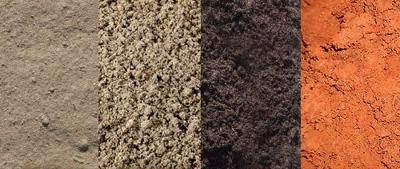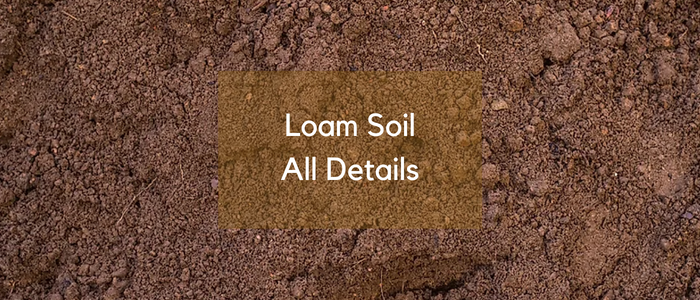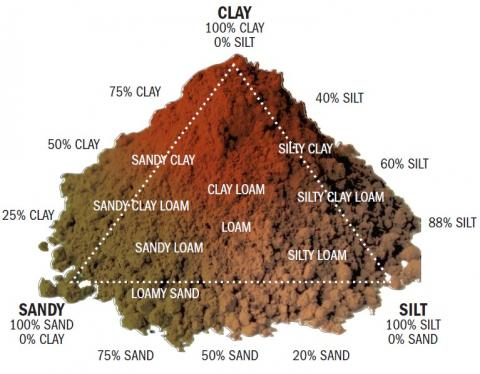What is Loam Soil?
Loam is a type of soil (soil classification) that is made from three main types of soil which are: sand, silt, and clay soil. There is a balanced ratio among the three soils that should be maintained to obtain the loamy soil. This balanced composition provides the ideal souil texture for the growth of plants.
It is probable that loam can exist naturally in soil beds in gardens. However, most of the time, you will need to adjust the existing mixture to reach the perfect one because the natural loam will usually exist in a different proportions.
Keep in mind, to enhance the quality of garden soil, you need time. It is not just an easy and quick fix task but at the end, the results you will get worth it.

How is loam different from topsoil?
Perfect Mixture for Loamy Soil
The mixture of the three soil types that give the perfect loam soil is as follows:
- Sand, constitutes approximately 40% by volume of the total soil.
- Silt, constitutes approximately 40% by volume of the total soil.
- Clay, constitutes the remaining 20% by volume of the total soil.
How the Perfect Mixture Work?
As we mentioned, the loam mixture consists of sand, silt, and clay.
Sand particles have the largest grain size. Although sand does not have the ability to hold moisture, sand provides pretty well aeration and drainage to the soil.
Among the loam components, silt particles are medium in size; they are better in water/moisture retention that sand but with less nutrients than clay.
Silt is the medium that assists with easier mixing of the sand and clay together.
Benefits of Loam Soil to Gardens
Loamy soil holds multiple benefits for the plants
The loam is capable of holding the nutrients for the plants. Also, loam possesses a texture able to retain water for the plant roots to access it and still drains well.
This indicate that loam provides the roots with enough water and at the same time, it finally removes the extra water away from the roots.
Add to the efficient providing of moisture and nutrients that loam soils have a loose and crumbly texture. The term given to this “friable”.
The friable soil provides extra space for oxyden to diffuse into the soil which is essential for root growth. In addition, loam soil allows easy spread of roots to reach the nutrients and water.
This makes loam an effective soil to use in your garden. Your plants mostly will not struggle to survive and will need need extra feeding and watering.
So, in summary, the loamy soil helps the growth of plants in 3 major ways.
- Aeration: The wide range of particle sizes that exist in loam soil results in a loosely packed soil that lets oxygen reach plant roots easily.
- Retention of nutrients: Loam’s clay content makes sure that nutrients stick to the soil rather than being rinsed away by water. Additionally, loam provides the perfect environment for the helpful bacteria that support plant growth.
- Moisture retention: Loam retains moisture well because water drains through it at the optimum rate—quickly enough to keep the soil from getting overly wet but slowly enough for plants to get the moisture.
So, How to Create Loam for Your Garden?
We mentioned that loam soil combines three compounds: sand, clay and silt. However, if you just add sand to clay and mix them together, you will not create loam as you may expect.
Thus, one way to get loam soil at the end is to not try to create the correct proportions of all components right away; Instead improve your soil by start adding organic matter. This provides nutrition for the soil organism and makes it capable of converting to a loamy mixture with time.
It takes time and effort to develop loose, loamy, fertile soil for gardens. Adding organic matter to the soil each year is a continuous process that turns your current soil into loam. The well-draining conditions that plants require are produced by the decaying organic matter. Additionally, organic matter draws advantageous organisms that maintain the soil’s health and vibrancy. As they break down, chopped up leaves, straw, and completed compost all combine well to produce rich, loamy soil.
Unfortunately, the amount of organic matter quickly depletes as it breaks down. It is necessary to supplement the soil each season, ideally in the fall, for this reason. The soil’s balance will determine how much organic matter needs to be added. Your soil might need to have significant amounts of organic matter added numerous times during the season if it is mostly heavy clay or highly sandy.
First, to know whether your garden has a loamy soil, do the following:
Take a handful of the slightly moist soil in your hand and roll it up tightly. When you open your hand, look at the soil: Loamy soil will remain in the shape of a delicate ball but will crumble when you poke it.
If your soil does not pass the previous test, this means your garden soil has an unbalanced combination of sand, silt, and clay. Sand may need to be added to soil that contains too much clay, but in general, incorporating organic matter into the soil is the best way to correct an imbalance. Incorporating organic matter into the soil draws beneficial organisms that eventually produce loamy, higher-quality soil. Here’s how to create loam by incorporating organic matter into your garden soil:
- Apply a layer of 5 centimeters of organic matter to your topsoil.
Do this layer in the late autumn as soon as your harvest is over. There are widely used organic materials that can be used such as compost, animal manure, green manure, dried leaves, and grass clippings.
- Moist that layers of organic material so that it gets fully waterlogged.
Allow it to rest all winter.
- Work the organic matter into the soil in the springtime to a depth of about 18 cm.
The soil can be more thoroughly mixed by using a rototiller. For long-lasting benefits, repeat the full procedure every year.
The Option of Buying
Bulk soil purchases can be a quick and simple method to get your garden or yard flourishing, but they can also be expensive. Additionally, while certification systems are available to assist customers, merchants, regulators, and others in identifying good quality soil, they are currently optional. Many businesses that sell soil get their soil from construction projects where it has been dug up for basements or to level a yard. In general, soil from excavation sites is not the best soil for gardens. Use that “fill dirt” soil type for other yard improvements instead of for plant growth.
If you want to purchase soil, compost, mulch, or other bulk garden supplies, research the supplier first. Never hesitate to ask questions. Adding mediocre soil won’t improve your garden and can even make your search for excellent soil more difficult. reputable and well-known soil manufacturers support their products.

